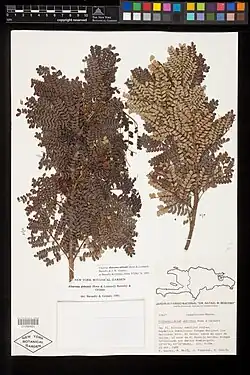Jupunba abbottii
| Jupunba abbottii | |
|---|---|

| |
| Scientific classification | |
| Kingdom: | Plantae |
| Clade: | Tracheophytes |
| Clade: | Angiosperms |
| Clade: | Eudicots |
| Clade: | Rosids |
| Order: | Fabales |
| Family: | Fabaceae |
| Subfamily: | Caesalpinioideae |
| Clade: | Mimosoid clade |
| Genus: | Jupunba |
| Species: | J. abbottii
|
| Binomial name | |
| Jupunba abbottii | |
| Synonyms[2] | |
| |
Jupunba abbottii (synonym Abarema abbottii), the Abbott abarema, is a species of plant in the family Fabaceae. It is endemic to the Dominican Republic, and is confined to broad-leaved woodlands on limestone soils.
Morphology
The tree is a perennial plant.[2] It is 4 to 12 metres tall, with rough grey bark.[3]
Distribution and habitat
Distribution: Restricted to north-east Dominican Republic, on the southern shore of Samana Bay and west towards Sa Quita-espuela.[3]
Habitat: A tree confined to broad-leaved woodland on limestone soils up to 800 metres.[3]
References
- ^ World Conservation Monitoring Centre (1998). "Abarema abbottii". IUCN Red List of Threatened Species. 1998: e.T36563A10002231. doi:10.2305/IUCN.UK.1998.RLTS.T36563A10002231.en. Retrieved 15 November 2021.
- ^ a b Royal Botanic Gardens Kew. "Jupunba abbottii (Rose & Leonard) Britton & Rose | Plants of the World Online | Kew Science". Plants of the World Online. Retrieved 26 March 2025.
- ^ a b c Silk Tree, Guanacaste, Monkey's Earrings, pt. 1., Mem. New York Bot. Gard. 74(1): 105. 1996
